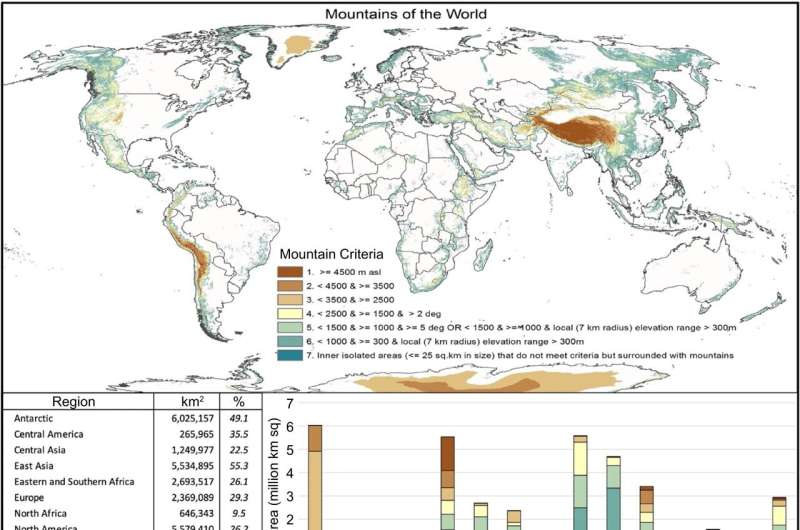This article has been reviewed according to Science X's editorial process and policies. Editors have highlighted the following attributes while ensuring the content's credibility:
fact-checked
proofread
Irrecoverable carbon in the mountains: Embracing the opportunity of agroforestry

Over 29% of global irrecoverable carbon, which once gone is not likely to recover in any reasonable timeframe according to scientific literature, is stored in mountains. This biomass, representing irreplaceable ecosystems, biodiversity, and globally significant ecosystem services, is under threat everywhere by demographic and environmental pressures, as Earth's rapidly changing global climate is affecting mountains at an accelerated rate.
This "mountain carbon" supports high levels of biodiversity, including many of the last remaining large mammal species on the planet.
Increased use of trees in mountain agriculture can lead the way towards conserving these irreplaceable resources and provide increased resilience and sustainability for mountain agricultural system, according to a new study revealing that even small incremental increases of as little as 1% increase per year in tree cover on agricultural land in mountains can provide significant climate change mitigation benefits within a decade while improving the livelihoods of smallholder farmers and benefiting biodiversity, ecosystems, and ecosystem services.
Building on multi-year work to quantify the extent, geographic distribution, and carbon mitigation potential of agroforestry, the study highlights to policymakers and institutions the significant sequestration potential and particular effectiveness of agroforestry practices in mountain agricultural systems to mitigate the effects of climate change while bolstering ecosystems, restoring degraded land and enhancing food security.
"Recently, there has been growing recognition in the land-use sector about the role of agroforestry to bolster mitigation efforts and strengthen small farmer adaptive resilience," said Robert Zomer, lead author of the study.
"The opportunity to achieve beneficial outcomes for both conservation and food production by increasing tree cover on farms and in farming landscapes in mountainous regions, including building resilience and soil health benefits, has been shown to be substantial and not to be ignored."
"Trees on farms are a road forward for transitioning to improved agricultural systems with lower carbon footprints and environmentally sound practices, and especially well-suited to providing ecoservice benefits within the often rugged and erosion-prone terrain of mountainous regions."
This paper quantifies the mitigation potential of multifunctional agroforestry systems and geospatially articulates the potential for increased tree cover in mountains. Two scenarios are evaluated to estimate the carbon sequestration potential of increasing tree cover on agricultural land: 1) incremental change and 2) a systemic change to agroforestry.
The mitigation potential within mountain agricultural systems is globally 0.5−0.7 PgC for incremental change and 1.1−2.7 PgC for systematic change (1 PgC = 1,000,000,000 metric tons of carbon). For example, a 10% increase in tree cover on all agricultural land within mountain regions is estimated to sequester about 3 PgC.
By comparison, above-ground losses due to tropical land use conversion have been estimated at 0.6–1.2 PgC per year, with net emissions from land use, land-use change, and forestry for the year 2020 estimated to be 1.6 ± 0.7 PgC.
"Agroforestry has many benefits particularly suited to mountain agricultural systems."
"The potential and importance of landscape agroforestry approaches for protecting irrecoverable carbon in mountains is by providing alternative, sustainable, and biodiversity-friendly livelihood options for mountain communities that take pressure off local biodiversity and other natural resources while improving livelihoods for some of the poorest farmers in the world," said Antonio Trabucco, senior scientist at CMCC.
"Resilient agroforestry systems can offer great opportunities to link adaptation and mitigation with climate change, and should be further stimulated within agriculture policy frameworks laying the groundwork for future political and financial support, as part of the long-term transformation of our global food system, laying the groundwork for future political and financial support, as part of the long-term transformation of our global food system", added Professor Donatella Spano of the University of Sassari and Strategic Advisor to the CMCC Foundation.
The research is published in the journal Circular Agricultural Systems.
More information: Robert J. Zomer et al, Irrecoverable carbon in mountains and the global mitigation potential of agroforestry and increased tree cover in mountain agricultural systems, Circular Agricultural Systems (2023). DOI: 10.48130/CAS-2023-0011
Provided by CMCC Foundation—Euro-Mediterranean Center on Climate Change




















